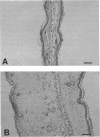Abstract
A newly developed fluoroquinoline, Q-35 (8-OCH3), in which a methoxy group was substituted at the 8 position of the quinoline nucleus, was very stable under irradiation with long-wave UV light (UVA). Derivatives, a fluoroquinolone with no substitution (the 8-H analog) and one in which a fluorine was substituted (the 8-F analog), were degraded in their solutions by the UVA irradiation. The phototoxic inducibility by these derivatives was further studied in a murine model. When mice were dosed orally with 800 mg of Q-35 (8-OCH3) per kg of body weight, the maximum dose given, and exposed to the UVA light, no inflammatory lesions were observed in their ears. Ear redness was marked in mice given more than 12.5 mg of the 8-F analog or 200 mg of the 8-H analog per kg. Histopathological changes, edema, and infiltration of neutrophils were also observed microscopically in groups receiving the 8-H or 8-F analog but not in groups receiving Q-35 (8-OCH3). Similar inflammatory reactions were observed to occur in a dose-dependent manner with other available fluoroquinolone antibacterial agents such as lomefloxacin, enoxacin, norfloxacin, ciprofloxacin and ofloxacin. These results suggest that the introduction of a methoxy group at the 8 position of the quinolone nucleus is important for the reduction of phototoxicity.
Full text
PDF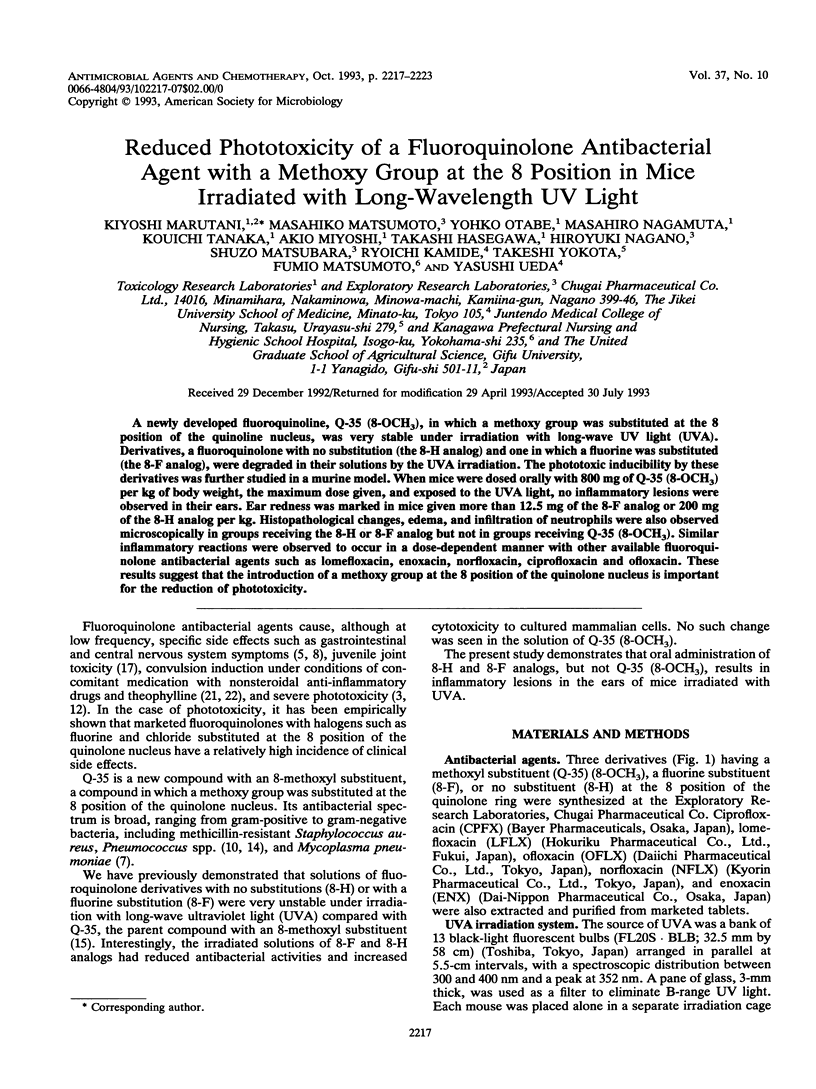
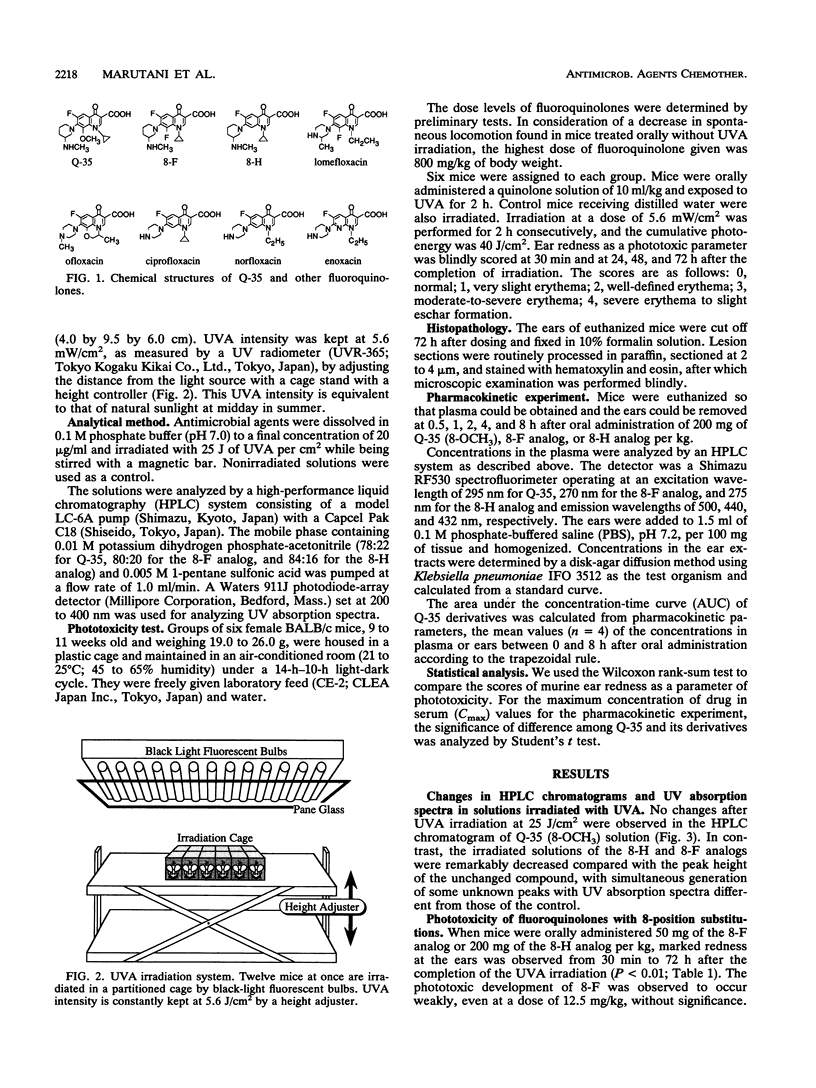
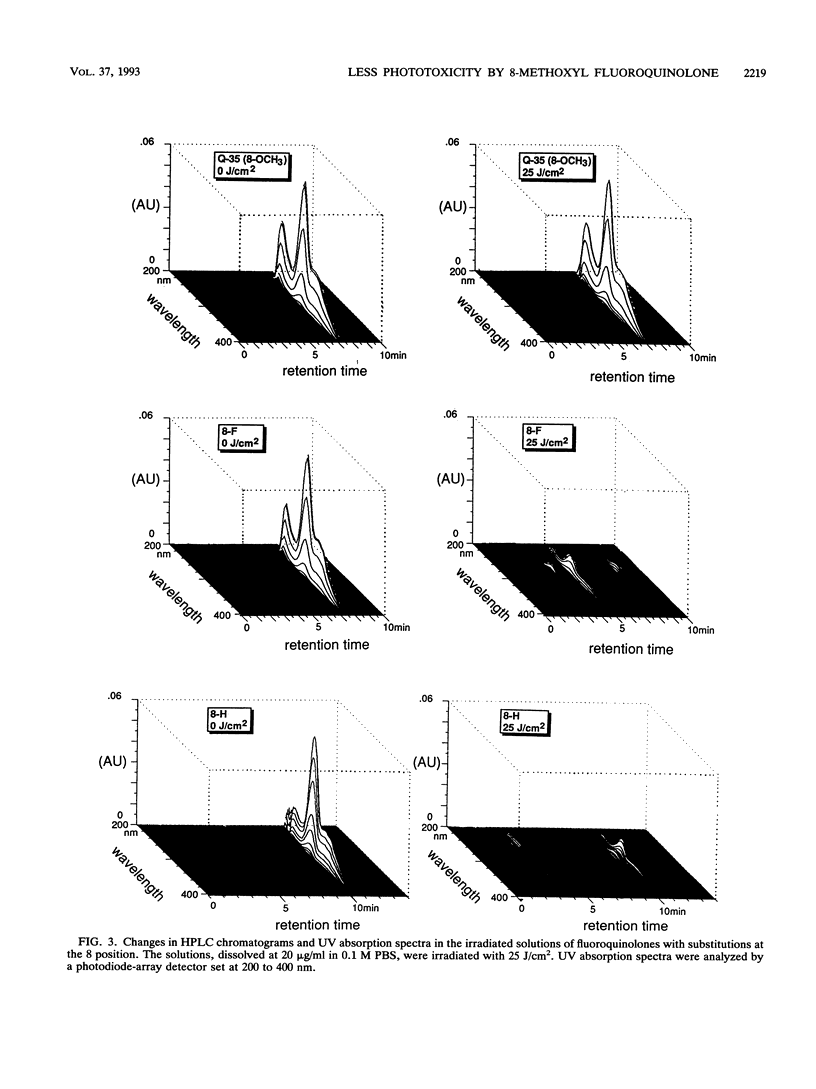
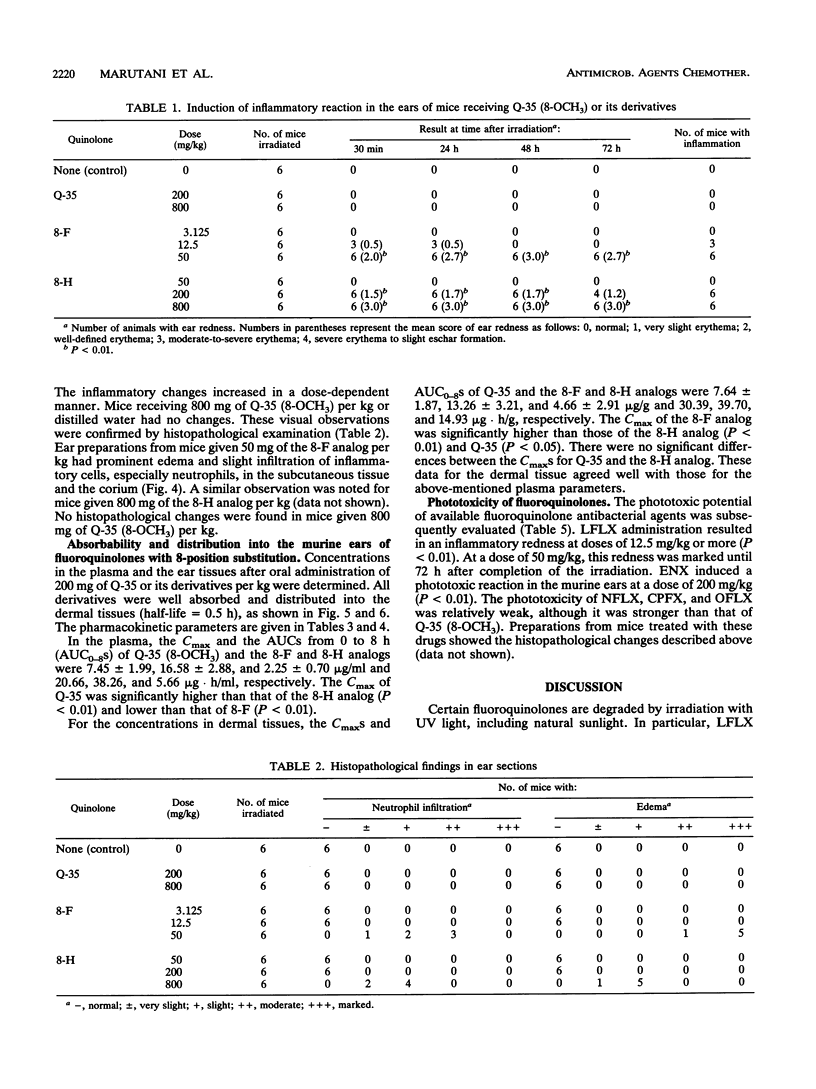
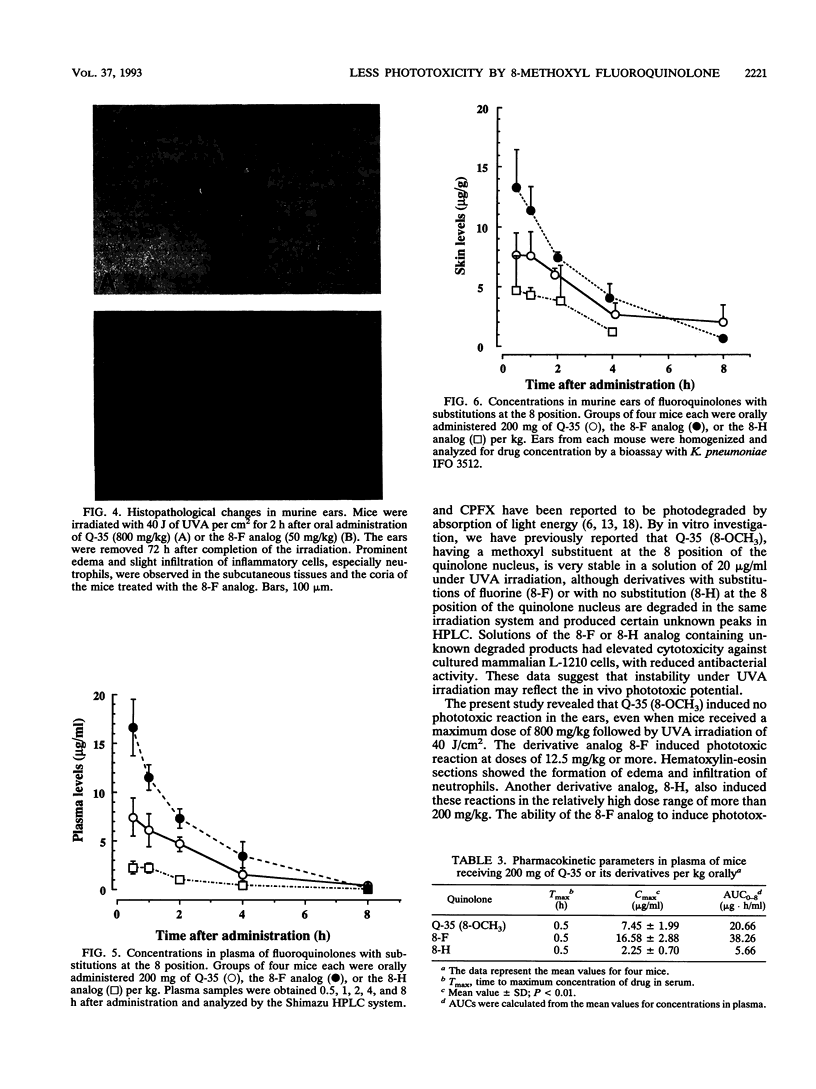
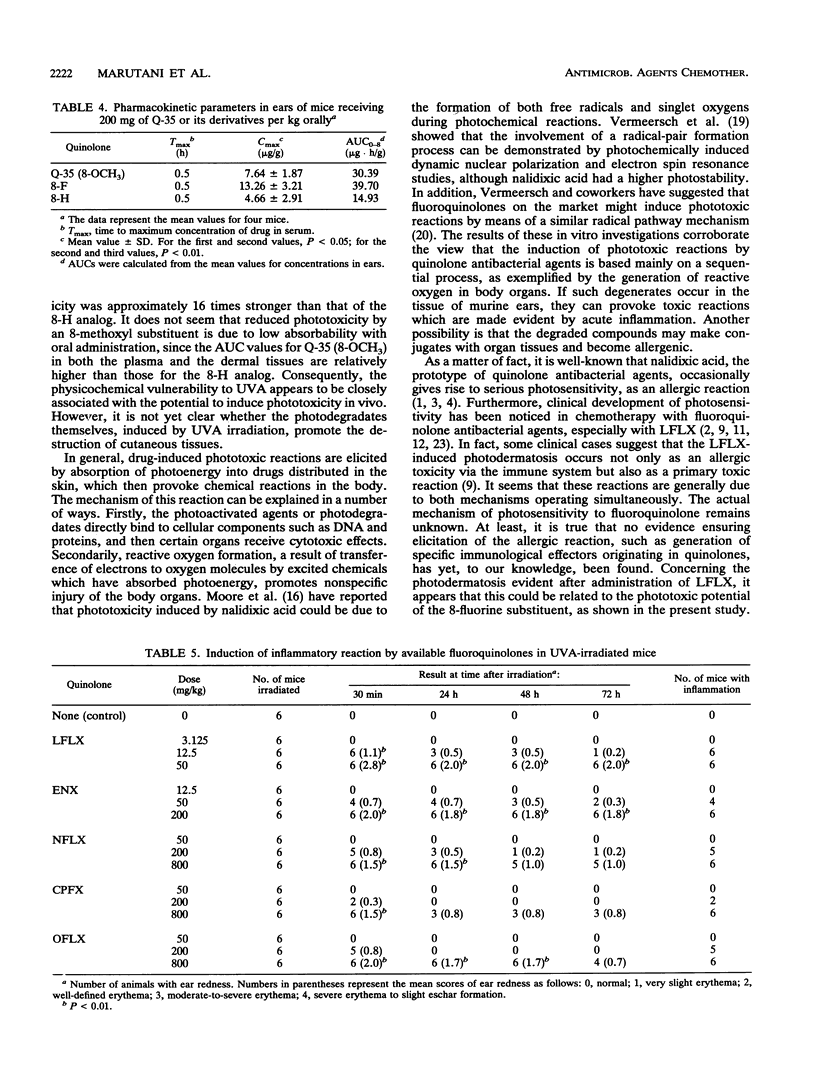

Images in this article
Selected References
These references are in PubMed. This may not be the complete list of references from this article.
- Baran R., Brun P. Photoonycholysis induced by the fluoroquinolones pefloxacine and ofloxacine. Report on 2 cases. Dermatologica. 1986;173(4):185–188. doi: 10.1159/000249247. [DOI] [PubMed] [Google Scholar]
- Birkett D. A., Garretts M., Stevenson C. J. Phototoxic bullous eruptions due to nalidixic acid. Br J Dermatol. 1969 May;81(5):342–344. doi: 10.1111/j.1365-2133.1969.tb13994.x. [DOI] [PubMed] [Google Scholar]
- Boisvert A., Barbeau G. Nalidixic acid-induced photodermatitis after minimal sun exposure. Drug Intell Clin Pharm. 1981 Feb;15(2):126–127. doi: 10.1177/106002808101500208. [DOI] [PubMed] [Google Scholar]
- Christ W., Lehnert T., Ulbrich B. Specific toxicologic aspects of the quinolones. Rev Infect Dis. 1988 Jan-Feb;10 (Suppl 1):S141–S146. doi: 10.1093/clinids/10.supplement_1.s141. [DOI] [PubMed] [Google Scholar]
- Ferguson J., Phillips G., McEwan J., Moreland T., Johnson B. E. Loss of antibiotic activity caused by photodegradation: in vivo studies. Br J Dermatol. 1988 Oct;119(4):550–551. doi: 10.1111/j.1365-2133.1988.tb03264.x. [DOI] [PubMed] [Google Scholar]
- Gohara Y., Arai S., Akashi A., Kuwano K., Tseng C. C., Matsubara S., Matumoto M., Furudera T. In vitro and in vivo activities of Q-35, a new fluoroquinolone, against Mycoplasma pneumoniae. Antimicrob Agents Chemother. 1993 Sep;37(9):1826–1830. doi: 10.1128/aac.37.9.1826. [DOI] [PMC free article] [PubMed] [Google Scholar]
- Halkin H. Adverse effects of the fluoroquinolones. Rev Infect Dis. 1988 Jan-Feb;10 (Suppl 1):S258–S261. doi: 10.1093/clinids/10.supplement_1.s258. [DOI] [PubMed] [Google Scholar]
- Iravani A. Efficacy of lomefloxacin as compared to norfloxacin in the treatment of uncomplicated urinary tract infections in adults. Am J Med. 1992 Apr 6;92(4A):75S–81S. doi: 10.1016/0002-9343(92)90314-2. [DOI] [PubMed] [Google Scholar]
- Ito T., Otsuki M., Nishino T. In vitro antibacterial activity of Q-35, a new fluoroquinolone. Antimicrob Agents Chemother. 1992 Aug;36(8):1708–1714. doi: 10.1128/aac.36.8.1708. [DOI] [PMC free article] [PubMed] [Google Scholar]
- Jensen T., Pedersen S. S., Nielsen C. H., Høiby N., Koch C. The efficacy and safety of ciprofloxacin and ofloxacin in chronic Pseudomonas aeruginosa infection in cystic fibrosis. J Antimicrob Chemother. 1987 Oct;20(4):585–594. doi: 10.1093/jac/20.4.585. [DOI] [PubMed] [Google Scholar]
- Leigh D. A., Tait S., Walsh B. Antibacterial activity of lomefloxacin. J Antimicrob Chemother. 1991 May;27(5):589–598. doi: 10.1093/jac/27.5.589. [DOI] [PubMed] [Google Scholar]
- Matsumoto M., Kojima K., Nagano H., Matsubara S., Yokota T. Photostability and biological activity of fluoroquinolones substituted at the 8 position after UV irradiation. Antimicrob Agents Chemother. 1992 Aug;36(8):1715–1719. doi: 10.1128/aac.36.8.1715. [DOI] [PMC free article] [PubMed] [Google Scholar]
- Moore D. E., Hemmens V. J., Yip H. Photosensitization drugs: nalidixic and oxolinic acids. Photochem Photobiol. 1984 Jan;39(1):57–61. doi: 10.1111/j.1751-1097.1984.tb03404.x. [DOI] [PubMed] [Google Scholar]
- Phillips G., Johnson B. E., Ferguson J. The loss of antibiotic activity of ciprofloxacin by photodegradation. J Antimicrob Chemother. 1990 Dec;26(6):783–789. doi: 10.1093/jac/26.6.783. [DOI] [PubMed] [Google Scholar]
- Vermeersch G., Filali A., Marko J., Catteau J. P., Couture A. Evaluation photophysique du pouvoir photosensibilisant de diverses quinolones. J Pharm Belg. 1990 Sep-Oct;45(5):299–305. [PubMed] [Google Scholar]
- Wijnands W. J., van Herwaarden C. L., Vree T. B. Enoxacin raises plasma theophylline concentrations. Lancet. 1984 Jul 14;2(8394):108–109. doi: 10.1016/s0140-6736(84)90283-6. [DOI] [PubMed] [Google Scholar]




